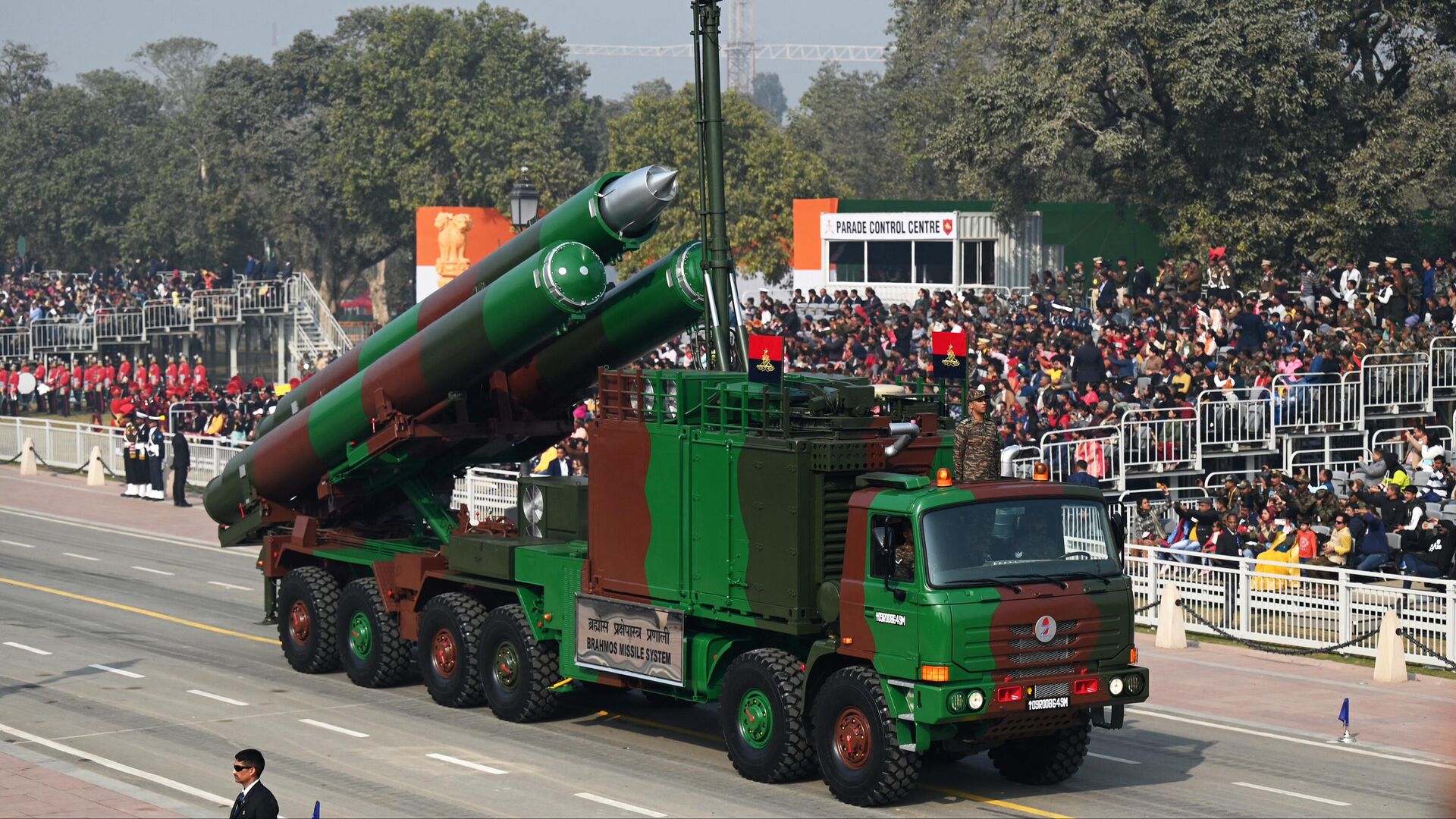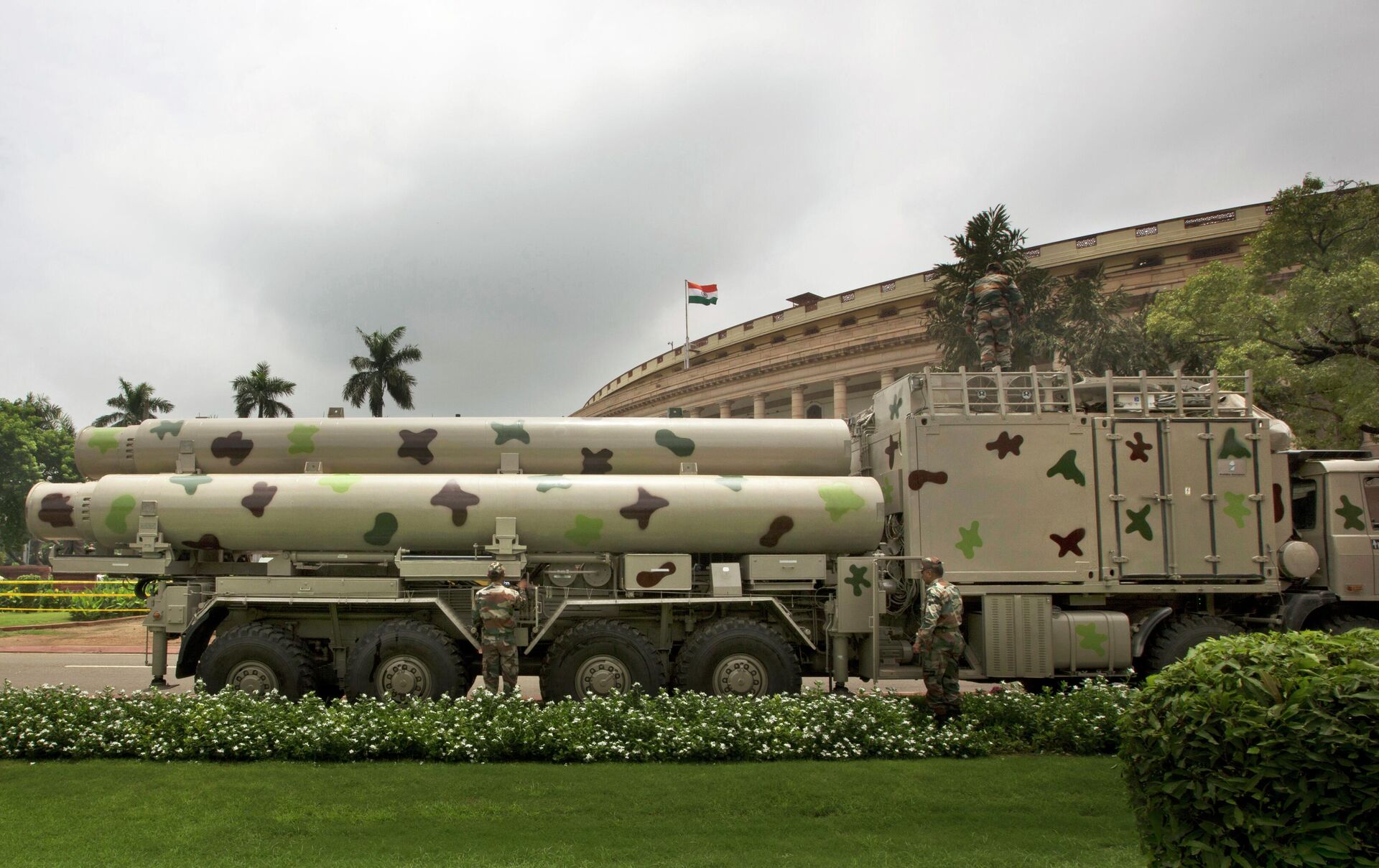https://sputniknews.in/20230801/pakistani-forensic-gurus-working-to-crack-brahmos-code-3315614.html
Pakistani Forensic Gurus Working to Crack Brahmos Code
Pakistani Forensic Gurus Working to Crack Brahmos Code
Sputnik India
A misfired Brahmos rocket that ended up landing in Pakistan last year gave local experts the chance to get a first-hand glimpse of what’s inside one of India's most dangerous weapons.
2023-08-01T17:25+0530
2023-08-01T17:25+0530
2023-08-01T17:54+0530
defenсe news
pakistan
pakistan army
brahmos supersonic cruise missile
lca tejas
drdo
islamabad
indian air force (iaf)
sukhoi su-30mki
russian arms supplies
https://cdn1.img.sputniknews.in/img/07e7/08/01/3320472_0:320:3072:2048_1920x0_80_0_0_20cd675a9967ab869163eed9d490d4d5.jpg
A recent case of espionage involving DRDO scientist Pradeep Kurulkar, closely associated with India's Brahmos missile, has brought into limelight India's arch-rival Pakistan's increasing efforts to decode the widely acclaimed projectile.Pakistan Allegedly Unleashes Spies to Unravel Brahmos RocketAccording to an investigation conducted by Maharashtra's Anti-Terrorism Squad (ATS), Kurulkar who was honey-trapped by a suspected woman Pakistani spy named "Zara Dasgupta", had told her that he would share "highly classified" information about the Brahmos missile when they meet in person.However, before the meeting between the alleged Pakistani intelligence operative (PIO) and Kurulkar, who served as the chief of DRDO's Research and Development laboratory, the latter was arrested by the Maharashtra ATS in May.The police probe also found that during her conversations with the Indian defense scientist on WhatsApp, the PIO repeatedly asked him about Brahmos.Subsequently, he informed her, "I cannot send a copy of that report to WA or mail. It is highly classified… I will trace and keep it ready when you are here. Will try and show you here," chargesheet filed by the Maharashtra ATS stated.During his tryst with Kurulkar, the PIO who introduced herself as Zara to him, had discussions on India's under-development long-range intercontinental ballistic missile Agni 6, Unmanned Combat Air Vehicles (UCAV), Surface to Air Missiles (SAM), Rustom (a medium-altitude long-endurance unmanned air vehicle), and other drone projects being undertaken by the DRDO.Among other Indian military hardware that featured in Kurulkar and the Pakistani spy's chats were the Indian Air Force's recent acquisition of Rafale warplanes, Akasha and Astra missiles, Quadcopters, and Meteor missiles.Why Brahmos Rocket Is a Headache for PakistanLast year in March, a Brahmos missile landed in Pakistan after being fired accidentally from a military base in Ambala city of Haryana state.Fortunately for New Delhi, the missile, often dubbed the Indian "Brahmastra", a celestial weapon used by Hindu deities to fight wars as mentioned in scriptures, was without a warhead at the time.As the missile wasn't carrying a warhead and it fell in an unpopulated region of Pakistan, no loss of life or property was reported from the neighboring country.However, the Pakistani air defense system failed to detect the hostile projectile, a development that would have delighted the military establishment in Delhi.There's little doubt that the Brahmos misfiring episode did raise questions about Islamabad's capability to track and destroy the supersonic missile.According to military experts in India, Pakistani radars cannot detect the Brahmos missile due to its supersonic speed. The missile's land variant which landed in Pakistan flies at a speed of 2.8 Mach (3,430 kms per hour).But the Chinese SAM does not have a proven history of detecting supersonic missiles that fly at a speed of 3,000 kmph and above. And, that's why it is believed that it proved inadequate in detecting the Brahmos missile that fell inside Pakistani territory.What Makes Brahmos Undetectable?Developed by India's Defence Research and Development Organisation (DRDO) and Russia's NPO Mashinostroyenia, the Brahmos missile is widely believed to be the world's fastest supersonic missile.The Brahmos' speed is a nightmare for air defense systems deployed all over the planet, including the US-manufactured Patriot Missile Defence System.Additionally, the Brahmos's supersonic speed gives it more lethality as like its derivative, the Russian Oniks missiles that have accomplished a 100-percent strike rate in Ukraine, the Brahmos is invulnerable from the enemy's air defense network.The Glorious Journey of BrahmosSince its maiden test in 2001, the Brahmos has undergone a slew of changes.Among the prominent advancements that the missile has made in the last two decades is its range which has been extended from 290 to 450 kilometers.Moreover, the missile can be fired from the IAF's Su-30MKI warplanes. It also has a naval variant that can be deployed on warships and submarines.Plus, Brahmos has a land version, making it one of the fewest missiles that can be used to attack the adversary from sea, air, land, and under ocean waters.DRDO is currently developing the next generation of Brahmos missiles, the Brahmos-NG. The new version of the weapon would be much smaller and lighter compared to the current one.These Brahmos-NG missiles are set to be fitted on India's homegrown fighter jet LCA Tejas which would form the bulwark of the Indian Air Force's combat aircraft fleet.
https://sputniknews.in/20230725/this-100-on-target-russian-brahmos-sends-chills-up-ukraines-spine-3167011.html
pakistan
islamabad
delhi
new delhi
india
haryana
maharashtra
ukraine
moscow
Sputnik India
feedback.hindi@sputniknews.com
+74956456601
MIA „Rossiya Segodnya“
2023
Pawan Atri
https://cdn1.img.sputniknews.in/img/07e6/0c/13/139630_147:0:831:684_100x100_80_0_0_8fa2b25903e7787fe6a2698552c167df.png
Pawan Atri
https://cdn1.img.sputniknews.in/img/07e6/0c/13/139630_147:0:831:684_100x100_80_0_0_8fa2b25903e7787fe6a2698552c167df.png
News
en_IN
Sputnik India
feedback.hindi@sputniknews.com
+74956456601
MIA „Rossiya Segodnya“
Sputnik India
feedback.hindi@sputniknews.com
+74956456601
MIA „Rossiya Segodnya“
Pawan Atri
https://cdn1.img.sputniknews.in/img/07e6/0c/13/139630_147:0:831:684_100x100_80_0_0_8fa2b25903e7787fe6a2698552c167df.png
misfired brahmos rocket in pakistan, brahmos rocket in pakistan, pakistan spies on brahmos rocket, india's brahmos missile, brahmastra of india's air force, pakistan brahmos decoding, pakistani spy activity brahmos, pakistani spy zara dasgupta, pakistan spying brahmos, drdo scientist honey trapped brahmos, drdo scientist pakistan intelligence operative brahmos, drdo scientist pakistan spy brahmos, brahmos pakistani spy drdo scientist, world's fastest supersonic missile,
misfired brahmos rocket in pakistan, brahmos rocket in pakistan, pakistan spies on brahmos rocket, india's brahmos missile, brahmastra of india's air force, pakistan brahmos decoding, pakistani spy activity brahmos, pakistani spy zara dasgupta, pakistan spying brahmos, drdo scientist honey trapped brahmos, drdo scientist pakistan intelligence operative brahmos, drdo scientist pakistan spy brahmos, brahmos pakistani spy drdo scientist, world's fastest supersonic missile,
Pakistani Forensic Gurus Working to Crack Brahmos Code
17:25 01.08.2023 (Updated: 17:54 01.08.2023) A misfired Brahmos rocket that ended up landing in Pakistan last year gave local experts the chance to get a first-hand glimpse of what’s inside one of India’s most dangerous weapons. Sputnik explains why the Brahmastra of India's Air Force is a headache for its neighbor.
A recent case of espionage involving DRDO scientist Pradeep Kurulkar, closely associated with India's Brahmos missile, has brought into limelight India's arch-rival Pakistan's increasing efforts to decode the widely acclaimed projectile.
Pakistan Allegedly Unleashes Spies to Unravel Brahmos Rocket
According to an investigation conducted by Maharashtra's Anti-Terrorism Squad (ATS), Kurulkar who was honey-trapped by a suspected woman Pakistani spy named "Zara Dasgupta", had told her that he would share "highly classified" information about the Brahmos missile when they meet in person.
However, before the meeting between the alleged Pakistani intelligence operative (PIO) and Kurulkar, who served as the chief of DRDO's Research and Development laboratory, the latter was arrested by the Maharashtra ATS in May.
The police probe also found that during her conversations with the Indian defense scientist on WhatsApp, the PIO repeatedly asked him about Brahmos.
In one of their exchanges on the messaging app, the Pakistani spy asked Kurulkar: "Brahmos was also your invention, babe…. The dangerous one." To that, the former DRDO scientist replied, "I have an initial design report of some 186 A4 size pages on all BrahMos versions."
Subsequently, he informed her, "I cannot send a copy of that report to WA or mail. It is highly classified… I will trace and keep it ready when you are here. Will try and show you here," chargesheet filed by the Maharashtra ATS stated.
During his tryst with Kurulkar, the PIO who introduced herself as Zara to him, had discussions on India's under-development long-range intercontinental ballistic missile
Agni 6, Unmanned Combat Air Vehicles (UCAV),
Surface to Air Missiles (SAM), Rustom (a medium-altitude long-endurance unmanned air vehicle), and other drone projects being undertaken by the DRDO.
Among other Indian military hardware that featured in Kurulkar and the Pakistani spy's chats were the Indian Air Force's recent acquisition of Rafale warplanes, Akasha and Astra missiles, Quadcopters, and Meteor missiles.
Why Brahmos Rocket Is a Headache for Pakistan
Last year in March, a Brahmos missile landed in Pakistan after being fired accidentally from a military base in Ambala city of Haryana state.
Fortunately for New Delhi, the missile, often
dubbed the Indian "Brahmastra", a celestial weapon used by Hindu deities to fight wars as mentioned in scriptures, was without a warhead at the time.
As the missile wasn't carrying a warhead and it fell in an unpopulated region of Pakistan, no loss of life or property was reported from the neighboring country.
However, the Pakistani air defense system failed to detect the hostile projectile, a development that would have delighted the military establishment in Delhi.
There's little doubt that the Brahmos misfiring episode did raise questions about Islamabad's capability to track and destroy the supersonic missile.
According to military experts in India, Pakistani radars cannot detect the Brahmos missile due to its supersonic speed. The missile's land variant which landed in Pakistan flies at a speed of 2.8 Mach (3,430 kms per hour).
Military watchers point out that Pakistan currently deploys the HQ-9 surface-to-air missile (SAM) for air defense purposes which it acquired from all-weather ally China in a deal signed in 2015. The Pakistan Army inducted it into service in 2021.
But the Chinese SAM does not have a proven history of detecting supersonic missiles that fly at a speed of 3,000 kmph and above. And, that's why it is believed that it proved inadequate in detecting the Brahmos missile that fell inside Pakistani territory.
What Makes Brahmos Undetectable?
Developed by India's Defence Research and Development Organisation (DRDO) and Russia's NPO Mashinostroyenia, the Brahmos missile is widely believed to be the world's fastest supersonic missile.
The Brahmos' speed is a nightmare for air defense systems deployed all over the planet, including the US-manufactured Patriot Missile Defence System.
Additionally, the Brahmos's supersonic speed gives it more lethality as like its derivative, the
Russian Oniks missiles that have accomplished a
100-percent strike rate in Ukraine, the Brahmos is invulnerable from the enemy's air defense network.
Though last year's misfiring incident allowed Pakistan to study the mainstay of India's missile arsenal, it appears as if it failed in its pursuit to decode it. That's perhaps the reason, its spy agency, the Inter-Services Intelligence or ISI, went as far as to lay a honey-trap for an Indian scientist who was closely linked to the Brahmos missile.
The Glorious Journey of Brahmos
Since its maiden test in 2001, the Brahmos has undergone a slew of changes.
Among the prominent advancements that the missile has made in the last two decades is its range which has been extended from 290 to 450 kilometers.
Moreover, the missile can be fired from the
IAF's Su-30MKI warplanes. It also has a naval variant that can be
deployed on warships and submarines.
Plus, Brahmos has a land version, making it one of the fewest missiles that can be used to attack the adversary from sea, air, land, and under ocean waters.
DRDO is currently developing the next generation of Brahmos missiles, the Brahmos-NG. The new version of the weapon would be much smaller and lighter compared to the current one.
These Brahmos-NG missiles are set to be fitted on India's
homegrown fighter jet LCA Tejas which would form the bulwark of the Indian Air Force's combat aircraft fleet.





